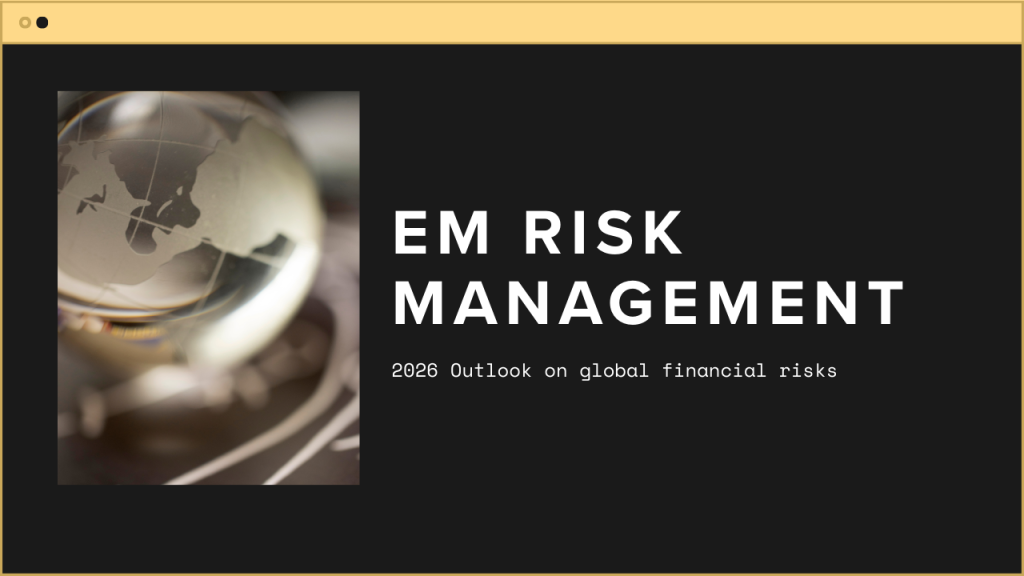
2026 Outlook: The Rising Importance of Risk Management
Emerging Markets (EM) in 2026 will offer high-return opportunities, but also heightened risks from elections, climate shocks, and global financial conditions. Investors can no longer rely on simple diversification; instead, systematic risk management frameworks are needed to protect capital and capture upside.
Risk in EM is multidimensional: macro, policy, market, credit, liquidity, and ESG-related. A forward-looking risk framework will determine not just survival but also competitive advantage for institutional investors.
Key Global Risk Drivers for 2026
- Monetary Policy Uncertainty
- Fed easing reduces global pressure but volatility in timing persists.
- ECB and BOJ policy divergence adds FX volatility.
- Geopolitical Flashpoints
- U.S.–China rivalry, Middle East instability, Russia–Ukraine conflict.
- Risks of trade block fragmentation and sanction regimes.
- Climate & Natural Disasters
- El Niño/La Niña cycles impacting agriculture.
- Extreme weather events hitting EM infrastructure and insurance sectors.
- Debt & Liquidity Risks
- Frontier markets face rising default risks.
- Global liquidity tightening due to banking regulation reforms.
- Technology & Cybersecurity Risks
- EM financial institutions exposed to cyber threats.
- Regulatory lag increases vulnerability.
Core Dimensions of EM Risk
Market Risk
- FX volatility in high-carry trades.
- Equity swings around elections and commodity cycles.
Credit Risk
- Sovereign debt sustainability (Argentina, Nigeria, Kenya).
- Corporate credit vulnerability in high-leverage sectors.
Liquidity Risk
- Shallow bond markets in frontier EMs.
- Capital flow reversals during risk-off episodes.
Policy Risk
- Sudden capital controls, taxation changes, subsidy rollbacks.
- Populist-driven fiscal spending increases.
ESG Risk
- Failure to comply with carbon transition policies.
- Mining projects halted by community opposition.
Frameworks for Managing EM Risk in 2026
- Top-Down Macro Stress Testing
- Model Fed, ECB, and China growth shocks.
- Assess cross-asset spillovers.
- Country-Level Risk Scoring
- Political stability index.
- Fiscal/monetary policy credibility scores.
- ESG readiness ratings.
- Portfolio Hedging Tools
- Use FX options and EM bond futures for downside protection.
- Allocate to gold and U.S. Treasuries as hedges.
- Liquidity Buffers
- Maintain cash buffers in EM allocations.
- Diversify funding sources across global banks.
Interim Insights (Mid-2026 View)
- EM investors in 2026 must be risk managers first, return seekers second.
- Risk-adjusted returns will be superior in countries with policy credibility and deep markets.
- FX and political volatility will be the two key battlegrounds for risk management strategies.
Risk Scenarios in 2026
- Fed Policy Misalignment
- If Fed cuts are slower than expected, EM assets may suffer renewed capital flight.
- China’s Hard Landing
- A sharp slowdown could trigger commodity price collapses and strain fiscal balances in LatAm and Africa.
- Geopolitical Shocks
- Middle East conflict escalation or South China Sea tensions disrupt trade routes.
- Sovereign Defaults
- Frontier EMs (Nigeria, Kenya, Pakistan) face higher restructuring risks.
- Climate Shock Event
- Food price spikes from agricultural disruption cause inflationary stress.
Investment Strategy Recommendations
- Diversify Across Asset Classes
- Combine equities, bonds, FX, and commodities within EM portfolios.
- Hedge with Developed Market Assets
- Hold U.S. Treasuries, gold, and USD cash buffers.
- Favor Strong Policy Anchors
- Overweight India, Mexico, Korea for policy credibility.
- Tactical Event Plays
- Use options and futures around election cycles.
- Integrate ESG Risk Filters
- Avoid sovereigns and corporates failing climate transition benchmarks.
Portfolio Construction Ideas
- Conservative EM Portfolio (2026)
- 40% EM Sovereign Bonds (IG overweight)
- 25% EM Equities (India, Mexico, Korea)
- 20% Commodities (Gold, Copper, Lithium)
- 15% Developed Market Hedges (UST, USD cash)
- Dynamic EM Risk-Managed Portfolio
- Actively rotate across EM assets using volatility signals.
- Hedge FX risk through options on MXN, INR, IDR.
- Add tactical positions in gold during geopolitical flare-ups.
Key Takeaways: Risk Management in 2026
Risk management in EM is no longer optional but central. The dispersion across regions, policies, and ESG alignment makes 2026 a year where selectivity and hedging define performance.
Investors adopting multi-layered frameworks — blending macro analysis, country scoring, and tactical hedges — will not only survive volatility but also capture opportunities.
Leave a Reply